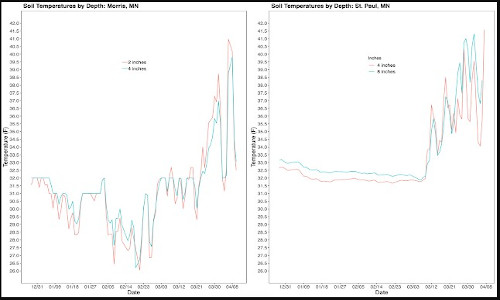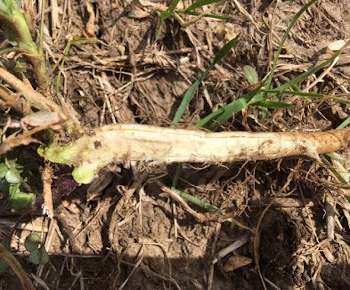By Jared Goplen and Dave Nicolai
Many alfalfa stands in southern Minnesota fared well through the winter of 2019-2020 and started to green up prior to the recent cold spell. Compared to previous years, the winter of 2019-2020 was relatively mild with sufficient snow cover to insulate the alfalfa crowns from lethal temperatures, aside from windblown ares of fields (Figure 1).
Crown temperatures in Morris and St. Paul, MN remained well above lethal temperatures this winter (Figure 2). Alfalfa producers should still take this opportunity to scout existing alfalfa fields to determine if areas of these fields have lower-than optimal stands due to stand age, disease, competition from weeds, or winter injury. Some winter injury has been noted in wind-blown areas of fields where insufficient snow cover allowed plants to desiccate or be exposed to lethal temperatures. Conducting a stand assessment this spring will help you make decisions related to stand management, cutting schedules, fertilizer applications, or stand replacement. The rest of this article will review stand assessment principles and management, frost damage to alfalfa, as well as discuss interseeding and replant options.

Figure 2. Soil temperatures under an alfalfa stand in Morris (left) and St. Paul (right), MN during the winter of 2019-2020. Temperatures briefly approached 20F in Morris, but remained relatively mild throughout the winter. Soil temperatures warmed considerably in early April.
Evaluating Stands

When making stand assessments this spring, make sure that the brown spots are actually dead. Some winter-injured plants may take longer to green up, even they are still alive. It is important to not make decisions too early.
It is also important to dig up a few plants to assess the crowns. Crown pith should be off-white and turgid, similar to a potato (Figure 3). If slow-growing plants are symmetrical with healthy-looking crowns, they will likely recover. More details on evaluating alfalfa stands, including how many stems per square foot constitutes optimal yield potential, can be found here:
Cold Injury
The recent cold spell has brought temperatures down into the single digits in some areas of southern Minnesota, where alfalfa had already begun spring growth. This very early growth has good cold tolerance. Despite the cold air temperatures, very little frost injury has been observed on alfalfa thus far. Areas of the state where spring growth has yet to occur or areas that received recent snowfall will likely be fine. Even areas of the state without snow cover appear to have fared well with frost injury being confined to the uppermost trifoliates. Temperatures near the soil surface likely remained warmer than air temperatures with recent cold temperatures, minimizing frost injury. Growth will resume from the stem and crown buds as soon as temperatures increase once again.
Next steps
Steps to decide whether to keep, terminate, or supplement the stand include:
- Evaluate forage and animal inventory as well as your crop rotation and replant options. Some fields should be rotated out of alfalfa and into another crop, like corn. Other fields could be supplemented by interseeding additional forages. The correct decision will vary by operation. Resources to assist in crop management decisions can be found here:
- Winter injury of alfalfa: Strategies for livestock producers - University of Minnesota
- Herbicide rotation restrictions for forages - University of Wisconsin
- Managing the rotation from alfalfa to corn – University of Minnesota
- Should I consider planting soybean? – University of Minnesota
- If alfalfa stands are thin or patchy and stand termination is not an option, there are a number of forage options to seed into winterkilled areas. The best option for your operation may depend on seed and equipment availability, as well as how many additional years are desired out of the stand. Several recommended options are listed in Table 1. Supplemental forages are ideally seeded with a no-till drill in the affected areas, but oftentimes conventional drills will work if the ground is somewhat soft.
- Consider seeding new stands this spring. The last few winters have been tough on perennial forages. This spring may provide a reasonable opportunity to seed new stands with field conditions improving in some areas. Resources related to stand establishment and fertility management can be found here:
- Establishing forages – University of Minnesota
- Fertilizing Alfalfa – University of Minnesota
Deciding how to manage a winterkilled or injured alfalfa field adds unexpected costs and additional stress to the farming operation. Walking fields, evaluating forage needs, and making a plan now is critical to making the best decision for your farm. The resources provided here should help you make the decision to keep or terminate the stand, seed supplemental forage, purchase additional forage, and/or seed new alfalfa. The right answer for you will depend on your specific field and operation.
Table 1. Several recommended forage options for interseeding into an existing alfalfa stand that has suffered winterkill or winter injury. The ideal option will vary by situation, including field condition, equipment and seed availability, and forage requirements.
| Forage species | Ideal use | Yield potential | Forage quality | Seeding rate* | Seeding depth |
|---|
| | | T DM/a | | lbs/a | inches |
| Alfalfa | ONLY if stand was established last year. NOT recommended for older stands due to autotoxicity concerns. | 3-5 | Excellent | Open areas: 12
Thin areas: 6-8 | 0.25-0.75 |
| Small grains** | Spotty or thin stands to be terminated after this year. Likely best option if early-season forage is a top priority. | 1-3 | Moderate to
excellent | 60-90 | 1.5-2 |
| Sorghum-sudangrass | Spotty or thin stands to be terminated after this year when forage will be ensiled or if interseeding delayed until June.Could be seeded after 1st alfalfa cutting. If dry hay needed, substitute sudangrass (slightly easier to dry). | 2-3 | Moderate | 20-30 | 1-2 |
| Small grain followed by sorghum-sudangrass** | Spotty or thin stands terminated after this year when forage will be ensiled. Could be used for dry hay if harvested by the milk stage. Likely provides both early and late-season tonnage. | 3-5 | Moderate | 20-30 | 1-2 |
| Italian/ Annual ryegrass | Spotty or thin stands with 1-2 yrs of additional production desired. Best when forage not baled for dry hay. Good yields should be achieved by 2nd and later cuttings. | 3-5 | Good | Open areas: 25-30
Thin areas: 5-10 | 0.25-0.75 |
| Orchardgrass/ Tall fescue | Spotty or thin stands with 2 or more yrs of additional production. Excellent fit for dry hay. Not ideal for emergency forage as most yield is late-season in the seeding year. | 3-5 | Good | 5-10 | 0.25-0.75 |
| Red clover | Spotty or thin stands with 1-2 yrs of additional production; can be chopped for haylage or baleage or used as dry hay, but drying can be somewhat difficult. Red clover will cause slobbers in horses. | 2-4 | Excellent | 6-10 | 0.25-0 |
Source : umn.edu